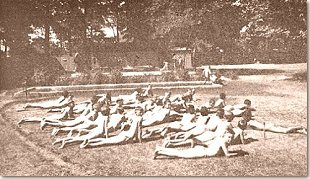
|
|
Young sanatorium patients sit outside under the blazing sun during what was called "heliotherapy". Sunbathing helped to kill the bacteria that cause TB |
Before the availability of drugs that successfully cured the body of tubercular infections, a widely accepted treatment for non-pulmonary tuberculosis was sunbathing. The sun had sometimes been blamed for increased activity in tubercular infection of the lungs and was therefore not used to treat this form of tuberculosis. However, the Sun offered several curative properties to those suffering from other types of tuberculosis. Sun treatment was used in the treatment of tuberculosis of the glands, bones, joints, peritoneum, skin, eyes, genito-urinary tract, and others.
There were several reasons for the prescription of sun treatment to tuberculosis patients. First of all, the sun acts as a bactericide, killing the Tubercular bacillus organisms that cause the disease. Exposure to moderately hot temperatures for extended periods of time is sufficient to kill off these bacteria and clear up infections. Furthermore, ergosterol, present in the skin in converted by the sunís UV rays into vitamin D, which was thought to do further damage to the TB bacilli.

|
|
Sunlamps like the ones pictured here were often used to replace natural sunlight in sun-therapy, or "heliotherapy" for tuberculosis (ca. 1925). |
|




